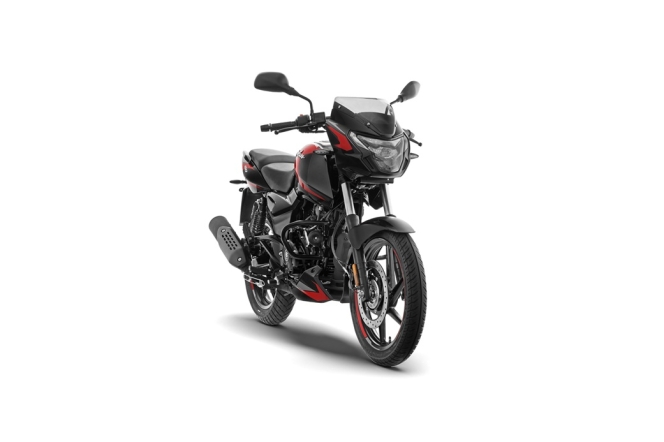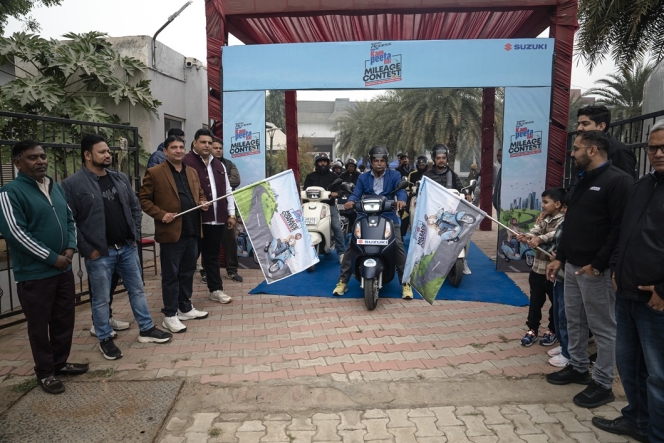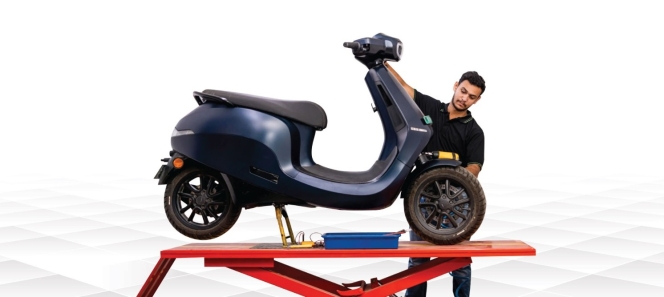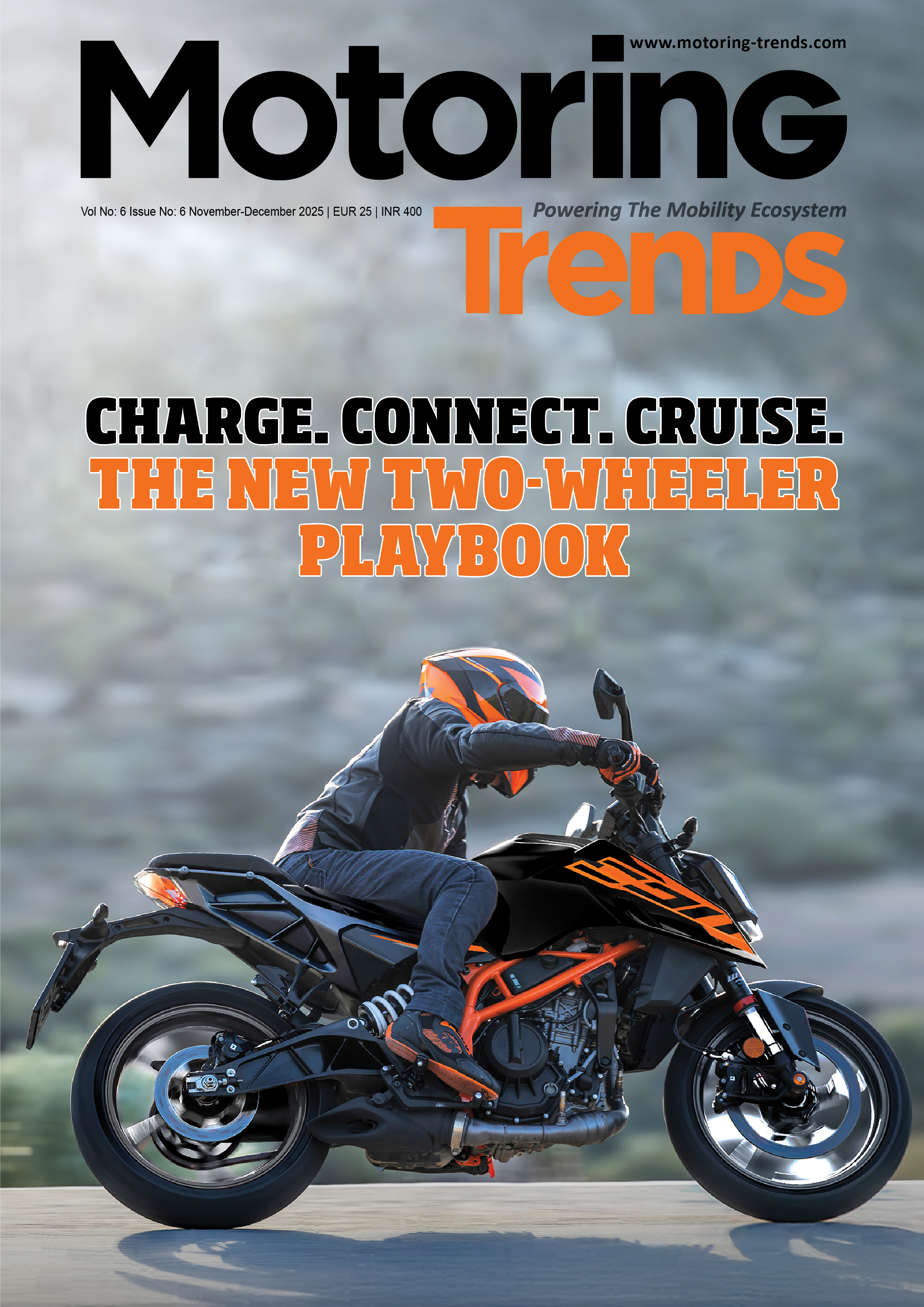Small Changes Make A Big Difference
- By Arup Das
- June 22, 2021

Design:
Royal Enfield has taken the tried and tested philosophy, ‘If it’s not broke, don’t fix it’, and we totally agree with it. The 2021 Himalayan, in terms of styling, is identical to the outgoing model. Mechanically also it receives no changes. So, it retains the same suspension setup, brakes and chassis as the BS6 version. The iconic motorcycle manufacturer has spruced the Himalayan up by introducing three new colour options: Granite Black, the eye-catching Pine Green and the Mirage Silver, which we have here with us, and it comes standard with a contrasting brown saddle. Sadly, Royal Enfield has discontinued Snow and Sleet Grey colours.
Based on the feedback received, Royal Enfield has tweaked the front rack frame on the fuel tank. By pushing the frame further up, thereby, there’s more knee room available for taller riders over 6 feet in height.
 Navigation system:
Navigation system:
No doubt one of the biggest updates the Himalayan gets is the navigation system or, as the company calls it, the Tripper display. It made its debut with the Meteor 350, which we’ve used extensively and found it quite helpful. One can sync their smartphone via the Royal Enfield app available on both Apple’s App Store and Google Play store. This Google Maps-based turn-by-turn navigation system is accurate and offers a seamless experience. The Tripper doesn’t read out phone or message alerts, which is a good thing as you are focused on the road.
The only hitch we found about the Tripper is that when you switch off the bike for whatever reason or at a traffic light, it sometimes doesn’t automatically pair back to your phone. It’s a slight inconvenience, but that’s not really a deal-breaker.
To accommodate the new additional pod in the instrument cluster, the windscreen is now wider from the bottom and taller as many Himalayan owners had complained the earlier model didn’t negate wind buffeting effectively. The new windscreen is only tinted.
New seat:
The previous Himalayan certainly had a comfortable seat, but it was a tad bit soft, making it unsupportive on long rides. Again, based on the feedback received from current Himalayan owners, Royal Enfield has added more padding to the saddle and have made it firmer. In terms of the seat height, it continues to be 800 mm, which makes it accessible for many. I’m a shade taller than 5 feet 9 inches in height and I can comfortably put my feet flat on the ground. The riding stance is comfortable as you don’t feel cramped. The footpegs are placed in a slight angular position, but nothing really to complain about. The seating position is commanding as well.
As an accessory, one can also opt for Touring Seats at an additional cost of INR 3,000.
 Additional upgrades:
Additional upgrades:
Coming to the rear carrier, it is now more aligned to the seat and has been reinforced with an additional metal plate to haul heavy luggage. It’s inscribed on the rear carrier that it can carry up to 7 kg of luggage, which is 2 kg more than the previous Himalayan.
Engine:
The 411cc engine remains the same mechanically and continues to churn 24.3 bhp of power and 32 Nm of torque. Ever since the Royal Enfield has introduced the fuel injection system in the Himalayan, it’s been a very smooth bike. It happily cruises anywhere around 80-100 kmph and effortlessly goes past the three-figure mark. We tip our hat to Royal Enfield for ensuring that the Himalayan’s vibrations are down to a minimal, making the riding experience quite enjoyable and comfortable both in the city and on the highway.
You open the throttle and the initial response is measured and it builds momentum in a linear fashion. The power doesn’t come rushing in a hurry as the low-end torque lacks the punch and feels flat. As the Himalayan is more at home when it’s out on open roads and covering long distances, it is happiest at the mid-range power band where the motor’s optimal power can be experienced. The Himalayan cruises comfortably at speeds over the three-figure mark, but the power tends to taper off after crossing 120 kmph.
 Ride and handling:
Ride and handling:
The Himalayan is a practical bike that can be used for your daily commute. Thanks to the soft suspension setup, along with the long travel, it easily cushions undulations and speed breakers in the city and at the same time feels at home on dirt tracks and overcomes ditches and potholes without a sweat. There are a couple of minor issues that Royal Enfield can iron out like the heavy clutch and hand brake lever, which can become quite a task. Also, the brakes lack the bite and feel spongy.
The Himalayan is a heavy motorcycle and weighs around 199 kg, and if and when you drop it, you can feel its weighty issues. But the beauty about this bike is that while on the go, it feels agile and light. You can easily navigate through traffic or extreme off-roading conditions.
Verdict:
It all comes down to brass-tacks and priced at INR 201,000, is the extra INR 10,000 justified? Maybe not, but you won’t find a more capable ADV bike at that range that is easy to manoeuvre and doesn’t overwhelm you with additional electronic nannies. The Himalayan keeps it simple and allows you to switch off the dual-channel ABS, though it wouldn’t be a bad idea if the Himalayan got traction control. Another thing we would like to see is tubeless tyres as it makes life a lot easier and spares you a lot of frustration, especially when you are on a long-distance ride. We would stick our neck out and say that it is a Jack of All Trades and a commuter-friendly adventure motorcycle that is very forgiving on your wallet. (MT)
Specifications:
Engine: 411 cc + 24.3 bhp + 32 Nm of torque
Transmission: 5-speed
Ground clearance: 220 mm
Seat height: 800 mm
Tyres & brakes:
Front: 90/90 – 21 inches / 300 mm disc
Rear: 120/90 – 17 inches / 240 mm disc
Dual-channel ABS

Bajaj Auto Intros Updated Pulsar 150 Range At INR 108,772
- By MT Bureau
- December 24, 2025

Bajaj Auto, one of the leading two-wheeler and three-wheeler manufacturers, has updated its popular Pulsar 150 motorcycle range. The updates include the introduction of LED headlamps and LED blinkers to the model, which the company states is intended to improve visibility and usability while maintaining the vehicle's design identity.
The updated range is available at the following ex-showroom Delhi prices – Pulsar 150 SD at INR 108,772, Pulsar 150 SD UG at INR 111,669 and Pulsar 150 TD UG at INR 115,481.
The motorcycle retains its frame and stance, though Bajaj has introduced new colour options and graphics. The Pulsar 150 continues to utilise DTS-i (Digital Twin Spark-ignition) technology, which uses two spark plugs to ignite the air-fuel mixture in the combustion chamber, intended to improve combustion efficiency and power output.
The update focuses on integrating modern lighting components into the existing platform, which originally established the sports motorcycling segment in India.
Sarang Kanade, President, Motorcycle Business Unit, Bajaj Auto, said, “The Pulsar 150 has defined performance motorcycling for generations. With this update, we have preserved its classic character while thoughtfully adding modern LED lighting, ensuring the Pulsar 150 remains relevant, recognisable and Definitely Daring.”
Suzuki Motorcycle India Conducts Access Mileage Contest In Palwal
- By MT Bureau
- December 24, 2025

Suzuki Motorcycle India (SMIPL), the subsidiary of Suzuki Motor Corporation, Japan, held a mileage contest for the Suzuki Access scooter in Palwal. The event involved 35 participants, including current owners and prospective buyers, to test the fuel efficiency of the scooter under city driving conditions.
The initiative is part of the brand’s ‘Pickup Bhi, Mileage Bhi’ strategy, which focuses on balancing engine performance with fuel economy and build quality.
The event was organised in partnership with RV Suzuki in Palwal. The participants, all of whom had purchased their scooters within the last year, followed a specific testing protocol: a designated 20-kilometre circuit on city roads, scooters were operated on a full tank, then refilled at the end of the journey to calculate the exact fuel consumed. Potential customers were provided with test rides and the opportunity to interview existing owners regarding reliability and comfort.
Deepak Mutreja, Vice-President, Sales & Marketing, Suzuki Motorcycle India, said, “The Suzuki Access Mileage Contest places a strong focus on fuel efficiency, bringing our brand promise of ‘Pickup Bhi, Mileage Bhi, Shandar Quality Ke Sath’ to life. By riding on city roads, participants experience the scooter’s real-world mileage. Along with mileage, customers also get to experience the quality and reliability that have made the Access a trusted choice of over 6 million customers. We appreciate the participation from customers in Palwal. We will continue to extend such on-ground initiatives to more cities across India, allowing customers to connect closely with out two-wheelers and witness their performance firsthand.”
The company intends to expand these on-ground initiatives to additional cities across India to demonstrate the performance of its two-wheeler portfolio in local environments.
Ola Electric Launches Hyperservice Centres With Same-Day Service Guarantee
- By MT Bureau
- December 23, 2025

Bengaluru-based electric vehicle maker Ola Electric has expanded its Hyperservice initiative by launching dedicated centres that offer a same-day service guarantee for eligible customers at no extra cost. The company will upgrade its existing service infrastructure into Hyperservice Centres, beginning with a facility in Indiranagar, Bengaluru.
The expansion is intended to reduce service lead times and increase transparency through a digital workflow.
The Hyperservice Centres include several facilities for customers and technical upgrades for vehicle maintenance. The waiting area includes a lounge and Wi-Fi connectivity for customers. Real-time visibility of the servicing stages is provided via the Ola Electric app. Going forward, the company plans to upgrade selected centres across India in the coming weeks.
Ola Electric has also transitioned Hyperservice into an open platform. This move makes the company’s spare parts, diagnostic tools, and training modules available to independent garages, mechanics, and fleet operators.
Under this model, parts can be purchased directly through the Ola Electric app or website. This is intended to allow garages and customers to access components without the use of intermediaries.
“As part of the ongoing service upgrade we are reimagining many of the fundamental aspects of the service experience. We see it as a core part of Ola ownership, and it needs the same level of innovation as the product itself. With Hyperservice Centres, we are setting a new benchmark – same-day service guarantee. At no extra cost for any customer. This is about using technology, process redesign and scale to remove friction and give every Ola customer a faster, simpler and more transparent service experience,” said the company in a statement.
The company has rolled out an in-app service appointment feature nationwide. The tool allows users to select service slots, track the status of their vehicle, and manage maintenance requirements within the unified platform to replace traditional booking methods.
Hajime Aota Appointed Chairman Of Yamaha Motor India Group
- By MT Bureau
- December 23, 2025

India Yamaha Motor, one of the leading two-wheeler manufacturers in the country, has announced the appointment of Hajime Aota as the Chairman of Yamaha Motor India Group, effective from 1 January 2026. He is set to succeed Itaru Otani, who held the position since November 2024.
The appointment comes as Yamaha continues its focus on the premium segment and digital integration within the Indian two-wheeler market.
Aota joins the Indian operations with experience in corporate strategy, planning and venture business development. He has held leadership roles in Japan, the United States and the United Kingdom.
Prior to this role, Aota served as Executive Officer at Yamaha Motor Co, and Chief General Manager of the Corporate Strategy Centre at the global headquarters in Japan. In these positions, he managed corporate strategy, sustainability and digital transformation.
He has also worked as Chairperson of Yamaha Motor Ventures & Laboratory Silicon Valley (YMVSV) overseeing investments in robotics, transportation, fintech and health technologies. He has also contributed towards Yamaha Motor Group’s long-term growth strategy.
Aota is a graduate of Keio University and holds a qualification from the Program for Leadership Development at Harvard Business School.
Hajime Aota, said, “I am very excited to begin my journey in India, one of the world’s most dynamic and diverse two-wheeler markets. The rapidly evolving aspirations of Indian consumers, especially the youth, align strongly with Yamaha’s focus on premium products, innovation, and a customer-centric approach. Leading Yamaha in India is a significant responsibility, and my focus is on strengthening the brand by delivering products that seamlessly combine Yamaha’s global engineering excellence with the evolving needs of Indian riders. I look forward to working closely with our teams and partners to drive sustainable growth and reinforce Yamaha’s presence in this important market.”






Comments (0)
ADD COMMENT